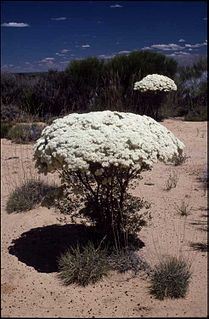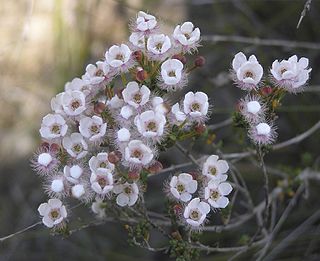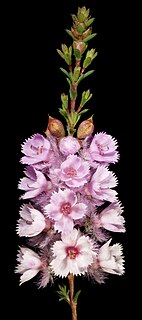
Verticordia brownii, commonly known as pink brownii or pink cauliflower is a flowering plant in the myrtle family, Myrtaceae, and is endemic to the south-west of Western Australia. It has small, neatly arranged, oval leaves and heads of pale pink to magenta or white flowers. It was one of the first verticordias to be collected, although it was not initially known by that name. The collection was made by Robert Brown on the Bass and Flinders circumnavigation of the Australian mainland on HMS Investigator.

Verticordia plumosa, commonly known as plumed featherflower, is a flowering plant in the myrtle family, Myrtaceae and is endemic to the south-west of Western Australia. It was the first species in the genus to be described, although initially given the name Chamelaucium plumosum. It is a shrub with linear leaves and rounded groups of scented pink, mauve or white flowers. Two varieties of this species have been declared as being "threatened".

Verticordia subulata is a flowering plant in the myrtle family, Myrtaceae and is endemic to the south-west of Western Australia. It is a woody shrub with pointed, linear leaves and in spring, heads of yellow flowers which turn red as they age.

Verticordia habrantha, commonly known as hidden featherflower, is a flowering plant in the myrtle family, Myrtaceae and is endemic to the south-west of Western Australia. It is a slender shrub with short, leafy side-branches and long flowering stems with rounded heads of mostly white flowers. Its hairy sepals are mostly hidden by the round, unfringed petals, and as a result, the plant looks like shrubs in the genus Chamelaucium, to which it is closely related.

Verticordia pennigera, commonly known as native tea, is a flowering plant in the myrtle family, Myrtaceae, and is endemic to the south-west of Western Australia. It is usually a small erect or prostrate shrub with small leaves and lightly-scented spikes of pale pink to magenta-coloured flowers in spring.

Verticordia halophila, commonly known as salt-loving featherflower, or salt-loving verticordia, is a flowering plant in the myrtle family, Myrtaceae and is endemic to the south-west of Western Australia. It is an erect, bushy shrub with small, crowded, thick leaves and spikes of red and pink flowers in spring.
Verticordia verticordina is a flowering plant in the myrtle family, Myrtaceae and is endemic to a small area near the coast of the south-west of Western Australia. It is a small, low-growing shrub with crowded leaves and in spring, scattered pale greenish-cream and golden brown flowers. Its unusual flowers and fleshy leaves give the plant a superficial resemblance to a Darwinia.

Verticordia picta, commonly known as painted featherflower or china cups, is a flowering plant in the myrtle family, Myrtaceae and is endemic to the south-west of Western Australia. It is a small to medium sized shrub with pink and cupped flowers that are sweetly scented.

Verticordia fastigiata, commonly known as mouse featherflower, is a flowering plant in the myrtle family, Myrtaceae and is endemic to the south-west of Western Australia. It is a prostrate or low shrub with small, club-shaped leaves and mouse-scented flowers which vary in colour from golden-yellow and orange to dark red.
Verticordia densiflora var. cespitosa is a flowering plant in the myrtle family, Myrtaceae and is endemic to the south-west of Western Australia. It is a shrub with small leaves and pink, or pink and white flowers. It is one of five varieties of the species Verticordia densiflora.

Verticordia humilis, commonly known as small featherflower, is a flowering plant in the myrtle family, Myrtaceae and is endemic to the south-west of Western Australia. It is a small shrub with leafy branches and scattered, mostly red flowers hanging loosely near the ends of the branches.

Verticordia inclusa is a flowering plant in the myrtle family, Myrtaceae and is endemic to the south-west of Western Australia. It is a small shrub with small, thick leaves and groups of scented, mostly white to pale pink flowers with a red centre on the ends of the branches in spring.

Verticordia lindleyi is a flowering plant in the myrtle family, Myrtaceae and is endemic to the south-west of Western Australia. It is sometimes an openly branched shrub, other times more or less dense, with small leaves and spreading, spike-like groups of pink or purple flowers along the stems in summer, sometimes also in autumn.
Verticordia luteola is a flowering plant in the myrtle family Myrtaceae, and is endemic to the south-west of Western Australia. It is a more or less openly branched shrub with crowded leaves on its side branches and spikes of pale yellow or bright pink flowers which turn cream to brownish as they age. This verticordia is a summer-flowering species.
Verticordia minutiflora is a flowering plant in the myrtle family, Myrtaceae and is endemic to the south-west of Western Australia. It is a bushy shrub with small, crowded, cylindrical leaves and groups of white to pale pink flowers in summer and autumn. As suggested by its botanical name, it has the smallest flowers of any verticordia.
Verticordia pityrhops, commonly known as East Mount Barren featherflower or pine-like featherflower, is a flowering plant in the myrtle family, Myrtaceae and is endemic to the south-west of Western Australia. It is a single-stemmed shrub which is densely-branched with crowded narrow linear leaves giving the impression of a miniature pine tree. When it flowers in autumn, the shrub is completely covered with masses of very small, honey-scented, pinkish-purple flowers.
Verticordia serotina is a flowering plant in the myrtle family, Myrtaceae and is endemic to the north-west of Western Australia. It is a shrub with egg-shaped leaves and bright pink flowers with long, curved styles in spring.
Verticordia sieberi is a flowering plant in the myrtle family, Myrtaceae and is endemic to the south-west of Western Australia. It is a shrub with one main stem, often compact but sometimes openly branched and with pink to pale purple flowers in summer and autumn.

Verticordia tumida, commonly known as summer featherflower, is a flowering plant in the myrtle family, Myrtaceae and is endemic to the north-west of Western Australia. It is an open shrub with very small leaves and clusters of deep pink flowers from late spring to early winter.
Verticordia wonganensis is a flowering plant in the myrtle family, Myrtaceae and is endemic to the south-west of Western Australia. It is a shrub which grows near Wongan Hills and has a single main stem, small leaves and spike-like groups of large, pink, feathery flowers.











